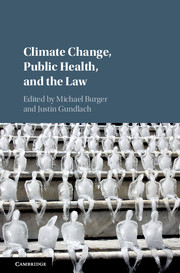Book contents
- Climate Change, Public Health, and the Law
- Climate Change, Public Health, and the Law
- Copyright page
- Contents
- About the Contributors
- Foreword
- Part I The Context
- Part II Cross-Cutting Issues
- Part III Impacts and Interventions
- Part IV Interplay with International & Domestic Environmental Law
- 12 International Institutions and the Developing World
- 13 How Existing Environmental Laws Respond to Climate Change and Its Mitigation
- 14 Incorporating Public Health Assessments into Climate Change Action
- Index
13 - How Existing Environmental Laws Respond to Climate Change and Its Mitigation
from Part IV - Interplay with International & Domestic Environmental Law
Published online by Cambridge University Press: 05 October 2018
- Climate Change, Public Health, and the Law
- Climate Change, Public Health, and the Law
- Copyright page
- Contents
- About the Contributors
- Foreword
- Part I The Context
- Part II Cross-Cutting Issues
- Part III Impacts and Interventions
- Part IV Interplay with International & Domestic Environmental Law
- 12 International Institutions and the Developing World
- 13 How Existing Environmental Laws Respond to Climate Change and Its Mitigation
- 14 Incorporating Public Health Assessments into Climate Change Action
- Index
Summary
Existing environmental laws interact with public health priorities and with aspects of the changing climate in numerous and varied ways. This chapter does not attempt to catalogue those interactions, but instead focuses on two that are especially important and illustrative of the operation and limitations of existing environmental laws vis-à-vis climate change-driven challenges. The first interaction is between pollution levels boosted by climate change and pollution control laws that employ health-based standards to determine pollution limits. The second is between a wider array of existing laws and the effects of climate change mitigation measures on public health. Examining these interactions reveals the inadequacy of existing laws to the tasks of (1) tracking the public health impacts of – much less adapting to – climate change, and (2) ensuring that climate change mitigation efforts reflect a rational accounting of impacts on public health, whether from foregoing mitigation or undertaking it.
- Type
- Chapter
- Information
- Climate Change, Public Health, and the Law , pp. 373 - 402Publisher: Cambridge University PressPrint publication year: 2018
- 1
- Cited by



